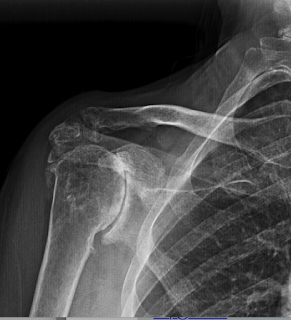What surgical treatments should be considered for a 72 year old woman with shoulder pain and stiffness and these radiographs? Her active flexion is to 100 degrees.
Of note she used to pitch softball and hardball, but hasn't been able to throw in 25 years. She single-handedly takes care of a 13 acre property.
She wished to avoid the potential risks and limitations of a reverse total shoulder and opted for a cuff tear arthropathy hemiarthroplasty (see this link and this link).
She returned a year after surgery with a comfortable shoulder that enabled her return to her desired activities. Her one year films are shown below. Note the load sharing between the humeral head on one hand and the glenoid and coracoacromial arch on the other.
Experience with the CTA hemiarthroplasty indicates that the risk of acromial fracture, instability, and implant failure are very low (see Managing rotator cuff tear arthropathy: a role for cuff tear arthropathy hemiarthroplasty as well as reverse total shoulder arthroplasty).
Follow on twitter: https://twitter.com/RickMatsen or https://twitter.com/shoulderarth
Follow on facebook: click on this link
Follow on facebook: https://www.facebook.com/frederick.matsen
Follow on LinkedIn: https://www.linkedin.com/in/rick-matsen-88b1a8133/
Here are some videos that are of shoulder interest
Shoulder arthritis - what you need to know (see this link).
How to x-ray the shoulder (see this link).
The ream and run procedure (see this link).
The total shoulder arthroplasty (see this link).
The cuff tear arthropathy arthroplasty (see this link).
The reverse total shoulder arthroplasty (see this link).
The smooth and move procedure for irreparable rotator cuff tears (see this link).
Shoulder rehabilitation exercises (see this link).





